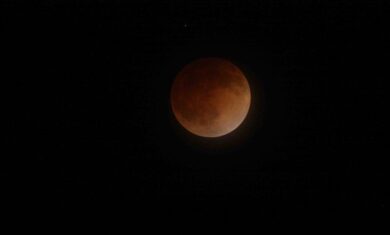How To Identify Planets in the Night Sky

Have you ever looked up at the night sky and wondered if a particularly bright star was actually a planet? It can be tricky business, but with some helpful tools to equip you, you’ll be identifying planets in no time! Follow this guide to figure out if what you’re looking at is a planet or a star.
Before we get started, we’re going to assume two things: first, that you’re not looking at the night sky with a telescope but rather with the naked eye, and second, that you’re in a place where your view isn’t blocked by large buildings, really tall trees, etc.
What Planets Are Visible By the Naked Eye?
The first step to identifying planets is to know which planets are possible to see without a telescope. Mercury, Venus, Mars, Jupiter, and Saturn are the five brightest planets in our night sky and, therefore, observable by most people. Of this list, Mercury can be the hardest one to spot… it is the closest planet to the Sun and is never seen too far from the Sun, so its low altitude and the glare of the rising or setting sun can make it hard to pick out.
Are Planets Visible At the Same Time Each Year?
In short, no. It is important to note that while we can see the brightest planets fairly regularly, there isn’t a single time in every year that is best for a particular planet. Planets move around the Sun at different rates and the Earth moves around the Sun, so the combination of these movements means we see planets in the night sky at different times each year.
What Do Planets Look Like?
The easiest way to pick out planets is to remember this quick rule of thumb: stars twinkle and planets don’t. Seen with the naked eye, planets and stars both appear as pinpoints of light. When you observe a star, you’ll notice that it twinkles and the light may appear to change colors. Planets don’t appear to twinkle much at all. Why the difference? Stars are MUCH farther away from us than planets, so the beam of light from a star is affected more by passing through our atmosphere than the beam of light from a much closer planet. Our air is the cause of twinkling. If you were out in space, neither planets or stars would twinkle at all!
Do Planets Always Look the Same?
Not exactly. Depending on how far a planet is from the Earth, it might look brighter or dimmer in the sky as compared to another time. The change in brightness for Jupiter and Saturn, for example, isn’t a huge amount. They are far enough from Earth that if we are a little closer or farther away, it doesn’t affect their brightness all that much. Mars, on the other hand, can look quite different from one year to the next. In late July 2018, Mars was around 40 million miles from the Earth and appeared very bright orange in the early evening sky. Several months into 2019 however, Earth had moved enough in its orbit that Mars was almost on the opposite side of the Sun—more than 200 million miles away! It was quite a bit dimmer at this point.
How close the planet is to the horizon also has a huge effect on how bright it appears. When a planet is high above the horizon, you are looking through less air to see it. When a planet is closer to the horizon, you are looking through more air, and so the planet will appear dimmer than when it was higher up in the sky.
Planets are also different colors! Mercury is white-ish in color and Venus is bright white. Mars is a rust-orange color. (We know, it’s called the Red Planet—what can we say? It’s orange.) Jupiter is a light tan color and Saturn is a yellow-ish tan color.
How To Know Which Planets Are Visible Tonight
Now that you know which planets are visible and what they might look like, you’ll need to know which planets are visible in your night sky. As previously mentioned, this will vary throughout the year and from year to year. It’s also important to note that you may not necessarily be able to see all five planets at the same time or in one night.
To get started, you can enlist the help of one of the following online resources that help you know what’s visible in your sky tonight.
Using the resources above, you can plug in the date you’ll be observing as well as your location to get a list of which planets are visible in your area, at what times, and their location in the sky.
I Know What Planet(s) I Can View Tonight—But How Do I Know Where To Look?
Let’s use an example from timeanddate.com to explore how we can use the information provided to us to find the planet we’re looking for. Here are the basics of our observing information:
Date of Sky Observing: 12/27/19
Location: Chicago, IL, USA
According to our date and location, we have the opportunity to see planets at the following times:
Mercury: From Saturday 6:51 am
Venus: Until Friday 7:04 pm
Mars: From Saturday 4:07 am
Jupiter: From Saturday 7:16 am
Saturn: Until Friday 5:36 pm
First, you may wonder what the terms “from” and “until” mean. To really understand these listings, you have to take the time of the rising and setting of the Sun into account for this specific location.
December 27, 2019, was a Friday. This listing assumes the reader is viewing the information on that day. From Saturday 6:51 am for Mercury means that the planet rose at 6:51 am on Saturday, December 28. Sunrise was at about 7:15 am that day, so for practical purposes, Mercury wasn’t visible because it was lost in the glare of the rising Sun. The same goes for Jupiter. From Saturday 7:16 am means that taking the time of sunrise into account, Jupiter rose at about the same time as the Sun did and also was not visible.
From Saturday 4:07 am for Mars means that it rose at about 4:07 am. Sunrise was at about 7:15 am, so Mars was visible—local weather permitting, of course!—after it rose until the glare from the rising Sun blotted it out around 45 minutes or so prior to sunrise.
We’re now going to focus on the planet Venus. According to Time and Date, for this particular date and this location, it was best to view Venus after sunset until around the time Venus set, which was a little after 7:00 pm local time. As visibility improved and the sunset glare faded, Venus would have been quite bright. Let’s pretend we wanted to look for Venus around 6:00 pm that night. The chart below shows where in the sky Venus was throughout December 27, 2019, and specifically at 6:01 pm, as denoted by the yellow circle and orange dotted line:
Imagine the whole sky as you see it as a dome with its edges resting on the horizon. This dome will help us find the altitude coordinate, which is the angle the planet makes with the horizon. The horizon line is 0° and the sky straight above your head is 90°. This point above you is called the zenith. (Note that altitude numbers can be negative. If you see a negative number for a particular time and date, that means that the planet will be below the horizon line from your location at that time and, therefore, not visible.)
To find the direction (also known as azimuth) coordinate, look for the degrees listing. If you face north and imagine the horizon all around you as a big flat circle, then true north is 0°, east is 90°, south is 180°, and west is 270°. At 6:01 pm on December 27, 2019, Venus had a direction of 233°. Since south is 180° and west is 270°, a direction of 233° places Venus about halfway between south and west.
Putting this all together: at 6:01 pm on Friday, December 27, 2019, Venus had an altitude of 9° and a direction of 233°. As seen from Chicago, this means that we would have found the planet very low in the southwest sky. Remember when we mentioned above about what a planet looks like when it is closer to the horizon? It was likely somewhat dimmer at this time, too.
A second way to find Venus’ location is via a mobile sky observing smartphone app. Some examples include Night Sky, Sky Safari, and Stellarium. Note that some apps are free, some cost money upfront, and some are free to start but require money to unlock certain features. We recommend doing your homework before you download.
Or, finally, for those who like a good challenge, you could do your planet-finding the “old fashioned” way and use the specific celestial coordinates to map the exact location in the sky on your own. Find a beginner’s guide on how to map celestial coordinates here.
And there you have it! You can now look for planets like a pro. Now go forth and impress your friends with your incredible knowledge—and get out and observe the sky!
Watch Skywatch Weekly To Gain New Stargazing Tips
Tour the night sky weekly with the Adler Planetarium’s Theaters Manager Nick, who using cutting edge visualizations, NASA images, and astrophotography to show you what you can see weekly in the night sky!
Chat With Our Astronomy Educators
Watch exclusive live episodes of Sky Observers Hangout in 2021! Every other Monday, our astronomy educators teach you about what it means to observe our sky, from catching a glimpse of the phenomenon known as Chicagohenge, to seeing a rare celestial event like the Jupiter and Saturn Great Conjunction of 2020. Subscribe to our YouTube channel to get updates about Sky Observers Hangout.







